Acupuncture for Animals, and an Introduction to Kalmeren Veterinary Acupuncture
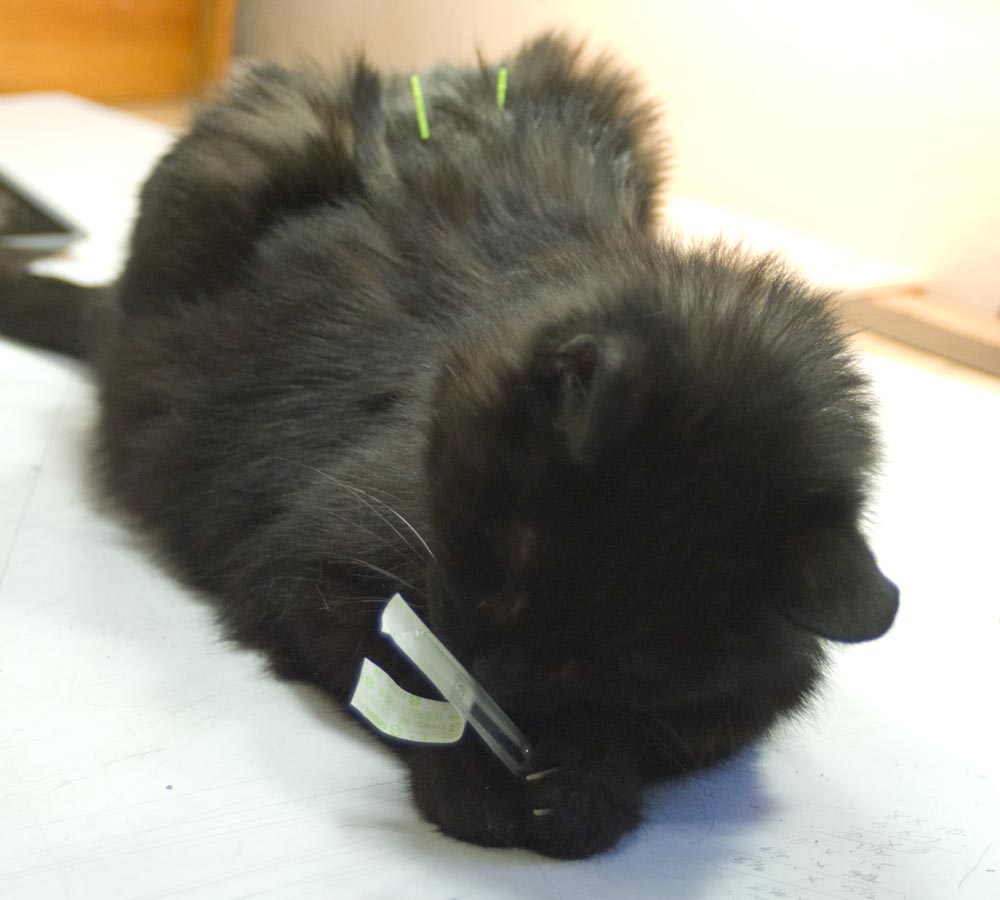
Acupuncture is a form of traditional Chinese medicine (TCM), one of humanity’s oldest healing practices, and helps the body bring itself back to balance with minimal invasiveness and typically no medicinals at all. Scientific studies have not necessarily proven exactly how acupuncture affects the body in the same way it can prove how medications and allopathic treatments work, but they have seen the body respond to the treatments and found that the treatments do have an effect for the conditions studied, mostly in the area of pain relief. It’s prescribed by many doctors and even covered by some insurance, and doctors and hospitals even offer the treatment as one of their services.
Likewise with animals, veterinarians and veterinary hospitals, acupuncture has become a widely accepted complement to allopathic medicine in treating a variety of conditions in pets, livestock and working animals and even wildlife and animals in zoos.
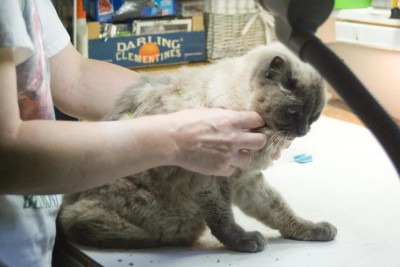
TCM views illnesses as imbalances in the flow of the body’s energy, or “Qi” (also “qi”, “chi” or “ch’i”), along its natural pathways throughout the body. In the west we don’t have an equivalent term for Qi, but if you think of how the blood physically circulates in the body, branching off in veins and arteries, entering organs, and returning again to the heart, you can also visualize how Qi flows along virtual pathways, and the consequences to the body’s health and vitality if the flow of blood or Qi is blocked.
The paths of this flow are called meridians, again compared to the vascular system carrying our blood all around our body, but these meridians have set points all along them that correspond to organs and areas of the body. Acupuncture involves stimulating these points, most often with very fine needles, in order to balance the flow of “Qi” through those points and thereby restoring the body to health. Many points are bilateral though a few fall along the midline or in individual areas, but each is associated with individual organs and the functions of those organs. If Qi is not flowing normally, it may be described in terms such as excessive or low, blocked, or rebellious, which means it’s flowing in the wrong direction, affecting the organ, area or process associated with that point.
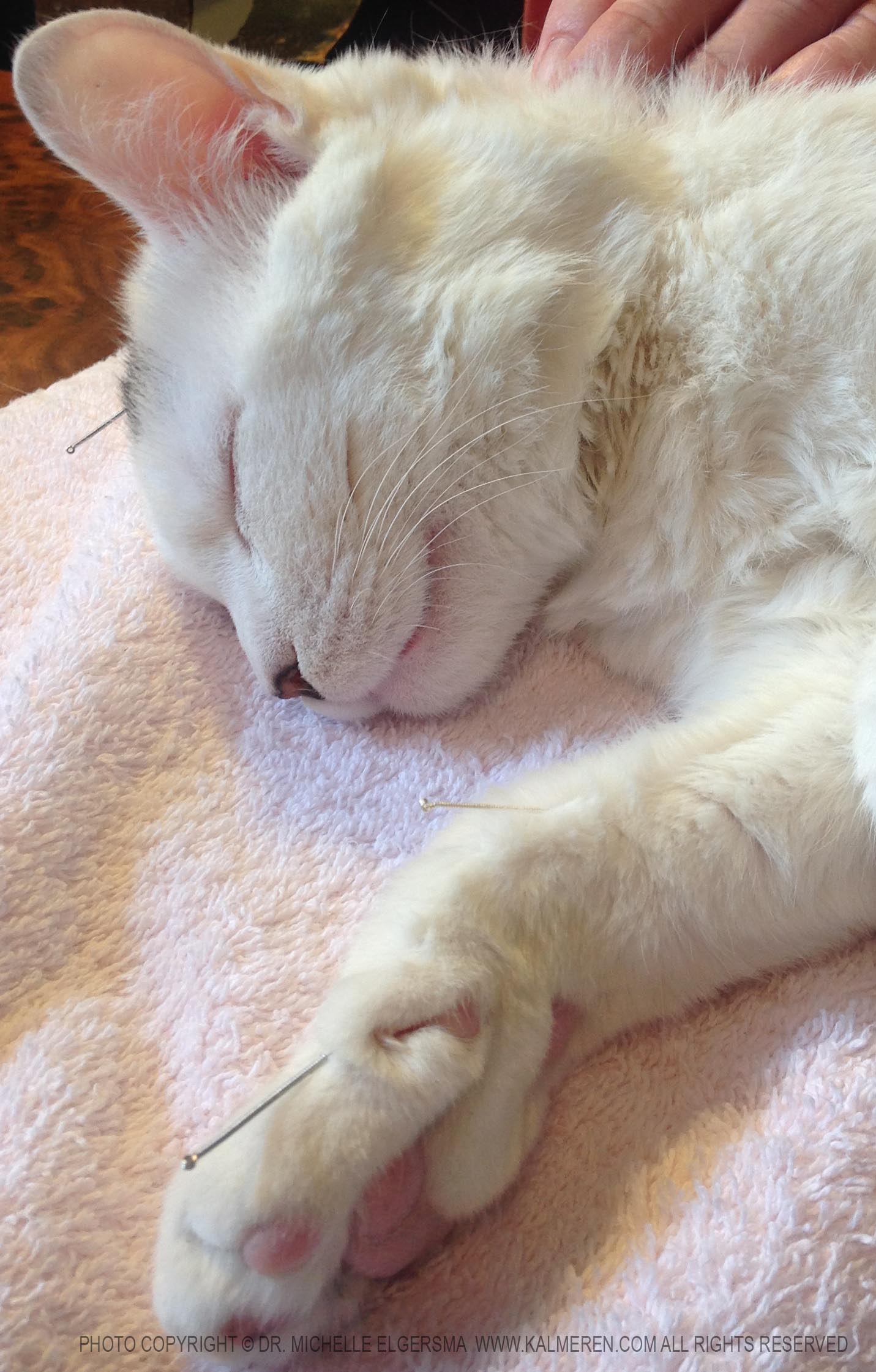
Veterinary Acupuncture
As it is for humans, acupuncture is a complement to other medical treatments. It’s recognized by acupuncture practitioners that balancing Qi is not going to heal a deep bleeding wound or a bacterial infection, but it can help the body deal with the pain of the condition and also help to reinforce the immune system by keeping the body functioning well and encouraging healing.
Because animals can’t be given many of the medications and treatments used in humans to make them more comfortable, acupuncture can often be used for pain control or relief, noninfectious inflammation and even paralysis, and this helps to provide relief from, control or heal conditions such as arthritis, disk disease, nerve injuries, asthma, allergies, skin conditions, and gastrointestinal problems as well as diabetes, renal issues, heart conditions and hyperthyroid disease.
In most countries, states, and provinces, veterinary acupuncture is considered a surgical procedure that only licensed veterinarians may legally administer to animals. Acupuncture treatment for animals is done by a veterinarian who has been certified in veterinary acupuncture because the meridians and points in animals are, as you would expect, different from humans, and even the needles used for different species are different sizes. Humans are nearly a uniform size and shape when compared to animals from the tiniest mouse to a Clydesdale horse, both of whom, and all animals in between, can benefit from acupuncture.
If the animal’s veterinarian is providing the treatment then the condition and history is already known, but if not the exam prior to treatment includes that history along with a general visual inspection as it would if you were to go to any veterinary specialist. TCM also checks the pulse and looks at areas of the tongue that also correspond with organs or areas of the body for distinctive areas of color, texture or hydration that tell the practitioner about the current state of the body.
And of course, since the patient can’t describe things, it’s up to the animal’s guardian to describe observations for the veterinarian. The practitioner will take all the information into account and determine where on the body and which needles to insert.
Animals endure acupuncture in just about the same way they do any other treatment and practitioners learn techniques to minimize any pain though it is minor. The needles used for smaller pets are much smaller than the hypodermic needles we always think of, and they are solid instead of being hollow like other needles so they aren’t gouging an opening in the skin, which is what actually causes a lot of the pain of being stuck with a needle. With larger animals with thicker skin like horses there may be discomfort as the needle is inserted, but small animal or large there is rarely any pain after the needle is in place. Needles need to remain in position for 15 to 20 minutes, but even if the pet moves and they fall out they’ll have an effect for having reached the point on the meridian.
The number of treatments needed varies. Acute conditions may only need a single treatment where chronic problems may need a series of treatments, often successively farther apart as the body adjusts to its restored flow of energy. Degenerative conditions may need ongoing regular treatments.
My experience with acupuncture for Emeraude and Lakota
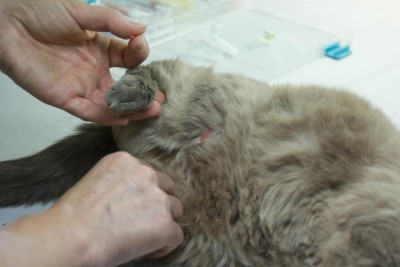
When Lakota grew ill in July 2013 Dr. Michelle Elgersma offered to give a complimentary acupuncture treatment when she stopped at my home for merchandise she had purchased.
Lakota was by that time in his final days and it was obvious to his veterinarian and me that nothing was going to cure him of his general organ failure at that point and we had only to keep him comfortable. Dr. Michelle’s treatment for Lakota had no visible effect, though it may have made him more comfortable. In the least, it did no harm, and that is one of the benefits of a treatment like acupuncture—it has no side effects so if it doesn’t work it simply has no effect.
I was surprised and very happy to see its effects on the painful diarrhea Emeraude repeatedly experienced, though, stopping it immediately along with the obvious abdominal pain from her inflammatory bowel disease, and even its effect on her encroaching renal condition. Her diarrhea began when Lakota first showed signs of failure. She continued eating but began to have stool with a lot of smelly liquid that same weekend. I changed foods and the conditions persisted, and it didn’t seem to be food related, and I tried other treatments (she was already getting pumpkin in her food) such as an anti-diarrheal and prednisolone, all to no effect.
Dr. Michelle explained about “rebellious Qi” that was flowing in the wrong direction, and “liver Qi anxiety”, so she chose to treat Emeraude for spleen Qi deficiency, commonly seen with diarrhea. She explained that in TCM the spleen causes the pure fluids that are absorbed from the stomach/intestines to raise up where they then spread throughout the body. When spleen Qi is low the fluids are not lifted and circulated and instead flow downward causing more fluid in the stool, i.e. diarrhea. The spleen is responsible for digestion and in general any Qi deficiency causes lethargy and dullness. In treating Emeraude Dr. Michelle tonified the spleen and also tonified Qi. By tonifying the spleen, she explained, she helped it do its job better. By tonifying Qi, she helped Emeraude have more energy and be brighter. She also did one point for the kidneys because in geriatrics, kidney energy declines.
The change was immediate, both in Emeraude’s diarrhea and in her personality. She began talking to me at that point and continued to the end, giving me face rubs and even licking my hand. She had her second treatment about two weeks after the first, not because the condition had returned but Dr. Michelle thought she could use a touch-up. The diarrhea did return again and she had a treatment about three weeks later, then again about four weeks after that, at the beginning of October, so the condition was clearing up right away and staying away longer. She developed the diarrhea again at the end of October, but it never became as bad and healed on its own after three days. She just needed enough treatments to get her energy back in order and after that could handle it on her own.
The effect on her renal issues was a marked improvement and they then remained stable so her appetite was fantastic and she stayed well hydrated on her own. In treating the symptom, the diarrhea, we actually treated her whole body, readjusting things so the whole system was in good working order again.
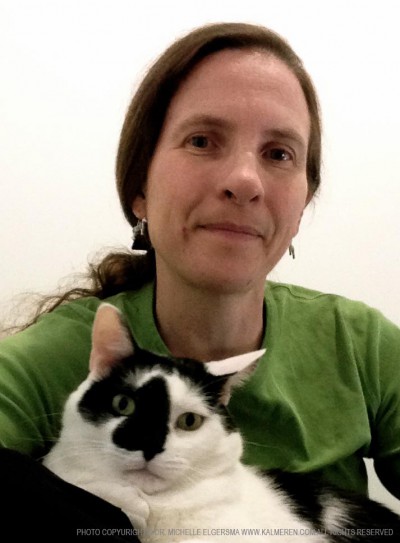
About Dr. Michelle
Michelle grew up just outside of Toronto, Ontario, close enough to the city but surrounded by agricultural areas. She developed a deep love for horses, which her mother claimed she inherited from both her grandfathers, and it was pretty clear from the beginning she was going to be a veterinarian of some sort.
She graduated in 1996 from the Ontario Veterinary College at the University of Guelph. Her first position was to fill in for a veterinarian on maternity leave at an agricultural veterinary clinic serving mostly dairy farms so of course all the visits were on site. She spent two years after that at a clinic that served both large and small animals, leaving when her husband was accepted for employment he really wanted at Princeton University in New Jersey.
She applied for a number of jobs and accepted one at the Parks Race Track near Philadelphia as a staff veterinarian from 1999 to 2012. Horses are boarded at the track and a few are trailered in for races, trainers are there each day. “We weren’t the state veterinarians that check each horse before each race,” she explained. “There were two of us, we arrived when training began at about 6:00 a.m. and visited each of the trainers to see what they needed that day, and that was what we did.” Races began at noon and there was little to do after that, but six days per week, and the track was open all year round, she helped heal lameness and pulmonary bleeding after races.
“We’ve all heard what horse racing is like, and you kind of choose your ethics,” Michelle described. “There were veterinarians who would do whatever a trainer asked, and there were trainers who would not work a horse beyond what it could do, but it was clearly a business.”
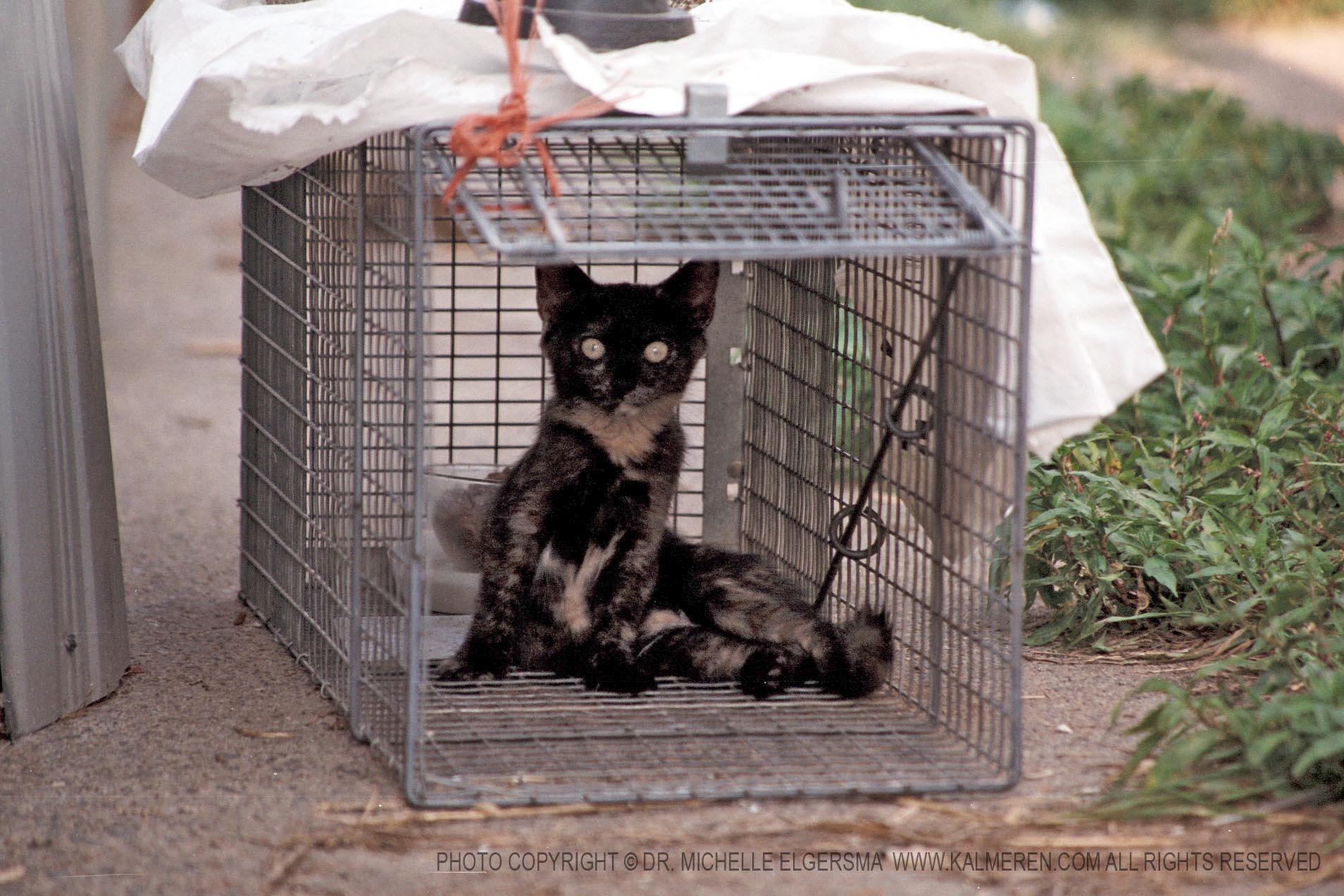
Horses and barns—and cats
“But this was where I began working with cats,” she said excitedly. Horses and barns go together, and barns and cats go together, and when she started she noticed a woman who would arrive twice a day to feed the three colonies on the site. The woman had no means to spay and neuter so there were kittens everywhere. Michelle began to help her feed, and then began to work with the woman to trap and spay/neuter every cat on the grounds.
“I couldn’t do the surgeries myself, I had no clinic there,” she said, “but I found a program at a shelter and also wrote a proposal to the Horseman’s Office for a grant to pay for spays and neuters.”
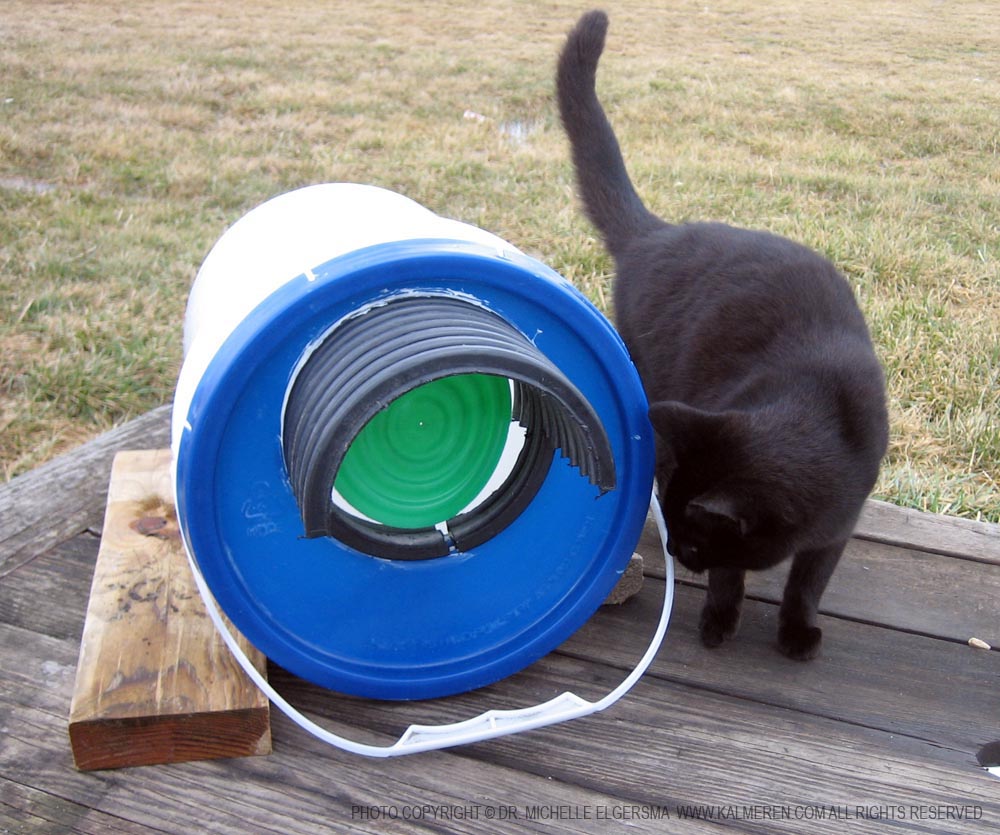
She also built shelters for them if they chose not to live in the barns, even devising small shelters out of dozens of five-gallon buckets from horse feed. Trainers and visitors noticed the cats remaining looked a lot better after the TNR was organized for them. A report in the Horseman’s newsletter when Michelle was leaving noted she’d spayed or neutered 360 cats in that time.
Another move
Her husband had accepted a position at Carnegie-Mellon University in Pittsburgh so Michelle left her position at the Park, stayed behind to sell the house then moved with her four cats.
Michelle had started studying veterinary acupuncture in 2012 prior to leaving the track and wanted to do something different with her career, receiving her certification through the International Veterinary Acupuncture Society. She had no idea about TCM, “And I thought ‘am I going to have to believe in all this Buddhist stuff?’ ” she said, concerned about her religious beliefs but found it all worked well together. She also found her traditional veterinary education, with its focus on conditions and treatments, and her holistic treatments through acupuncture also worked very well together.
Once she’d moved to Pittsburgh and considered the ways she could best use her training she decided on a mobile acupuncture practice rather than working in a veterinary clinic and founded Kalmeren Veterinary Acupuncture. “There seemed to be a market for it—there aren’t that many people practicing veterinary acupuncture here,” she said. “I hadn’t been in small animal practice in a while, and there really doesn’t seem to be a need for it, we have plenty of veterinarians in each neighborhood.
“I wanted to do a mobile so I’d have no overhead and I wouldn’t have to choose a place for my clinic, being new to the city,” she explained. “Then I drove around Pittsburgh and wondered how I would get around!” she laughed, mentioning tunnels that funnel the traffic and roads that wind around hillsides and one-way streets and dead ends, but she’s managed to find her way around.

“I get to see the animal in their own environment where TCM works best, they are less stressed and I can observe more about them than in a clinic,” she said. “It also gives me more time with the pet and their family and we’re all relaxed.”
She is currently treating disk disease in a few dogs, a cat with radial nerve paralysis in its front paw. Her cat Glitch, pictured with her above, has HCM and is receiving both acupuncture and a Chinese herb as part of his treatment. All seem to be doing well.
Dr. Michelle also volunteers with trapping cats for the Homeless Cat Management Team’s clinics and also volunteers to transport cats with the Underground Railroad Rescued Kitty Network (URRKN). She and her husband have four feline fur children.
. . . . . . .
Many thanks to Dr. Michelle for answering all the questions I had about veterinary acupuncture. Her complimentary treatments for Lakota and Emeraude did not influence my opinions of the practice or of her; I’d been wanting to learn more about the practice and I also like her demeanor as a practitioner and find her veterinary career very different from most veterinarians I know.
Read more articles in the category Veterinary Medicine
Browse some rescued cats and kittens!
All images used on this site are copyrighted to Bernadette E. Kazmarski unless otherwise noted and may not be used without my written permission. Please ask if you are interested in using one in a print or internet publication. If you are interested in purchasing a print of this image or a product including this image, check my Etsy shop or Fine Art America profile to see if I have it available already. If you don’t find it there, visit Ordering Custom Artwork for more information on a custom greeting card, print or other item.
© 2014 | www.TheCreativeCat.net | Published by Bernadette E. Kazmarski
—
Weekly schedule of features:
Sunday: Essays, Pet Loss, Poetry, The Artist’s Life
Monday: Adoptable Cats, TNR & Shelters
Tuesday: Rescue Stories
Wednesday: Commissioned Portrait or Featured Artwork
Thursday: New Merchandise
Friday: Book Review, Health and Welfare, Advocacy
Saturday: Your Backyard Wildlife Habitat, Living Green With Pets, Creating With Cats
And sometimes, I just throw my hands in the air and have fun!
—



Pingback: The Creative Cat - Daily Photo: Visitors!
Pingback: The Creative Cat - An Update on Kennedy
Pingback: The Creative Cat - Cats for Adoption: A Very Special Lucky Boy